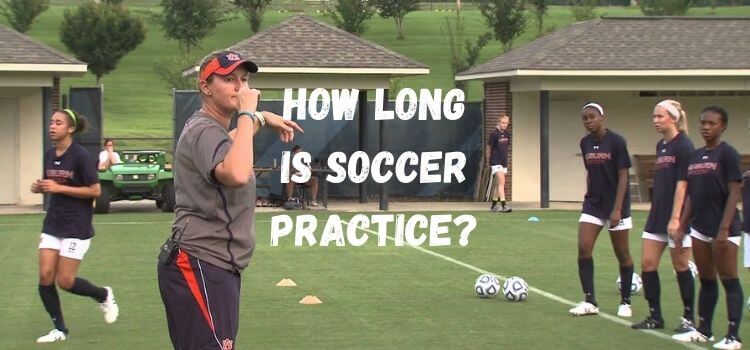As an Amazon Associate, I earn from qualifying purchases
Soccer practice is the cornerstone of developing skills, strategy, and teamwork. Understanding soccer practice’s optimal length and structure is crucial whether you’re a coach, player, or parent. This manual will explore the several aspects that affect how long a practice lasts and offer suggestions for organizing productive training sessions.

Understanding Soccer Practice Duration
Factors Influencing Practice Length
The duration of soccer practice can vary widely based on several factors:
- Age Groups: Younger players typically have shorter practice sessions than older players.
- Skill Levels: Beginners may require different training durations than advanced players.
- Team Goals: The objectives of the practice, whether it’s skill development, tactical understanding, or fitness, also play a role.
Youth Soccer Practice
Typical Duration for Different Age Groups
- Under 6 Years: Practices usually last 30-45 minutes, focusing on basic skills and fun activities.
- Under 12 Years: Sessions can extend to 60-90 minutes, incorporating more skill drills and small-sided games.
- Under 18 Years: Practices might last between 90 minutes to 2 hours, emphasizing tactical training and conditioning.
Benefits of Appropriate Practice Length for Youth
Appropriately timed practices ensure that young players remain engaged and motivated without experiencing burnout. It allows them to develop skills progressively and maintain a love for the game.
High School Soccer Practice
Standard Practice Duration
High school soccer practices typically last between 90 minutes to 2 hours. This duration helps balance intensive training with academic responsibilities.
Balancing Academics and Athletics
High school athletes must juggle their education and sports commitments. Effective time management and structured practice sessions help maintain this balance.
College Soccer Practice
Intensity and Length
College soccer practices are more intense and usually last 2 to 3 hours. They are designed to meet competitive college soccer’s physical and tactical demands.
Balancing College Life and Training
College athletes must balance rigorous academic schedules with demanding training sessions. Time management and prioritizing recovery are essential.
Professional Soccer Practice
Average Duration for Professional Teams
Professional soccer practice can range from 90 minutes to 2 hours, depending on the season and the team’s schedule.
Differences in Pre-Season vs Regular-Season Training
Pre-season practices often involve longer and more intense sessions to build fitness, while in-season practices may focus more on tactics and recovery.
Components of a Soccer Practice
- Warm-Up: 15-20 minutes of dynamic stretches and light exercises to prepare the body.
- Skill Drills: 30-45 minutes focusing on passing, shooting, and ball control.
- Tactical Training: 20-30 minutes on team formations and strategies.
- Conditioning: 15-20 minutes of fitness drills.
- Cool-down: 10-15 minutes of stretching and light activities to aid recovery.
Customizing Practice Length
Adjusting Based on Team Needs
Practice duration should be flexible to address the team’s specific needs. Younger or less experienced teams might need shorter, more frequent practices, while advanced teams might benefit from longer, more intensive sessions.
Importance of Flexibility
Flexibility in practice duration helps accommodate players’ varying energy levels and learning curves, ensuring they remain motivated and effective.
The Role of the Coach in Practice Duration
Setting Expectations
Coaches must set clear expectations for practice length and structure. This ensures players are mentally and physically prepared for the session’s demands.
Ensuring Effective Use of Time
Efficiently organized practices help maximize the time spent on the field, ensuring that each minute contributes to the players’ development.
Incorporating Rest and Recovery
Importance of Rest Days
Rest days are crucial to preventing overtraining and guaranteeing that athletes stay fit and injury-free. Typically, teams should have at least one rest day per week.
Active Recovery Strategies
Active recovery techniques, like yoga or brisk running, can help players recover without sacrificing their fitness level.
Special Considerations
Off-Season Training
During the off-season, practices might be less frequent but can focus on maintaining fitness and working on individual skills.
Practice During Competitive Seasons
In-season practices often focus on tactical preparation for upcoming matches and maintaining player fitness.
Individual Training vs. Team Training
Individual training sessions help players work on specific skills, while team practices focus on tactics and teamwork.
Parental Involvement in Youth Soccer
Supporting Appropriate Practice Durations
Parents should ensure their children’s practice schedules are balanced and not overly demanding.
Encouraging a Healthy Balance
Encouraging children to balance soccer, academics, and other activities is crucial for their development.
Common Mistakes in Soccer Practice Duration
Overtraining
Overtraining can lead to injuries and burnout. It’s essential to monitor players’ workloads and ensure adequate rest.
Undertraining
Conversely, undertraining can result in insufficient skill development and fitness levels.
Ignoring Individual Needs
Each player has unique needs and abilities. Practices should be adjusted to cater to these differences to ensure optimal development.
Tips for Effective Soccer Practice
- Goal Setting: Clearly defined goals help focus the practice sessions.
- Monitoring Progress: Regular player performance assessment helps make necessary adjustments.
- Adjusting as Needed: Flexibility to change practice plans based on players’ progress and feedback ensures continued improvement.
Conclusion
Soccer practice duration varies based on age, skill level, and team goals. Balancing training with rest and recovery, customizing practice sessions, and involving parents in youth soccer are crucial for practical training. By understanding these factors, coaches, players, and parents can ensure that soccer practice remains beneficial and enjoyable.
Frequently Asked Questions (FAQs)
For children (under six years), 30-45 minutes is perfect. As they grow older, practices can extend to 60-90 minutes.
This depends on the team’s age and skill level. Youth teams may practice 2-3 times a week, while high school and college teams may practice 5-6 times weekly.
Symptoms include persistent fatigue, decreased performance, frequent injuries, and lack of enthusiasm for training.
Players should focus on specific goals, actively engage in all drills, and seek coach feedback to improve.
Individual training helps players develop personal skills, while team practice focuses on tactics and teamwork.
Read Our More Articles
- How to Coach U8 Soccer: A Comprehensive Overview
- How to Practice Soccer by Yourself at Home: Tips and Tricks
- How Does the Soccer Practice End? A Comprehensive Guide
As an Amazon Associate, I earn from qualifying purchases


